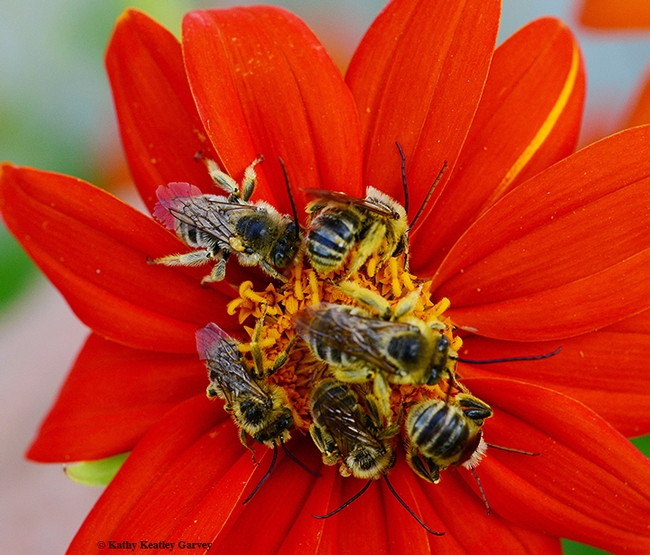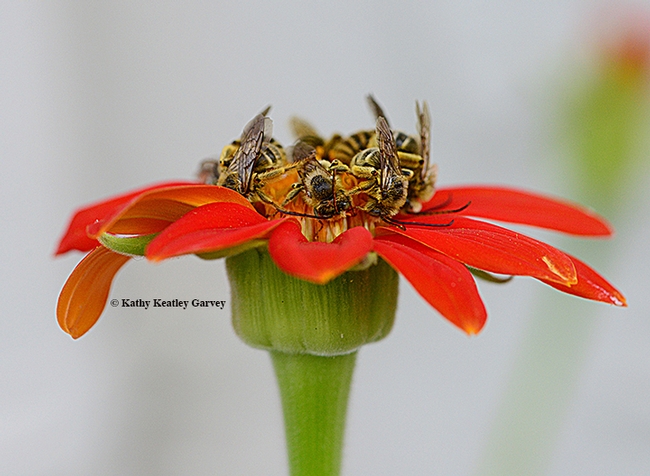- Author: Kathy Keatley Garvey
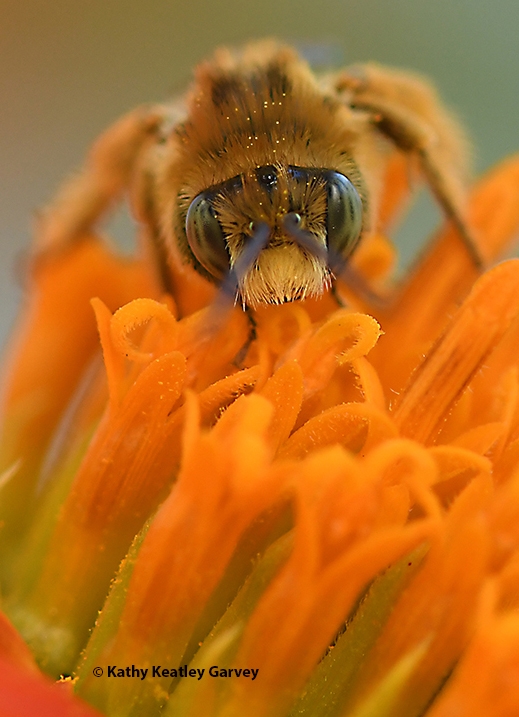
Don't bring a pillow, a night-cap or an attitude—it's Boys' Night Out and we're sleeping outside on the flowers.
That's what the male longhorned bees, Melissodes agilis, do while the females return to their underground nests at night.
"It's a bee B&B," quipped Lynn Kimsey, director of the UC Davis Bohart Museum of Entomology and distinguished professor, UC Davis Department of Entomology and Nematology.
This native species is among California's 1600 species of undomesticated bees.
Ever seen a Boys' Night Out? It's fascinating. The boys curl into a comma, or doze with their heads down and striped abdomens up.
Over the last two weeks, we've been monitoring the number of males sleeping on a single Mexican sunflower, Tithonia rotundifola, in our Vacaville pollinator garden. On the first night, two. Then three, then four. The slumber party grew to five last night. They sleep on a 10-foot-high blossom (talk about height advantage and a bird's eye view)! Every night, they return to the very same blossom.
A few years ago we saw the males sleeping on our lavender stems and then they moved to Gaura stems, probably due to the proximity of three praying mantids.
Folks ask if they sting. No. Boy bees don't sting. They can't.
The late Robbin Thorp, distinguished emeritus professor of entomology and co-author of California Blooms and Bees: an Identification Guide for Gardeners and Naturalists, fielded scores of questions on these slumbering bees. “They (males) lack a stinger which is a modified ovipositor in their wasp ancestors. Boy sleeping aggregations are based on a suitable perch and not related to where females are nesting, but probably no more than 100 yards from the nearest female nest. Females nest in the ground and have rather distinctive round holes about the diameter of a pencil or slightly smaller, sometimes with small piles of dirt around them looking like mini-volcanos. The holes may be widely separated or clustered together depending on the species, but each female digs her own burrow."
Of course, not all slumbering bees in this area are Melissodes agilis, as Thorp pointed out. Some may be other species of the genus Melissodes and some may belong to the closely related Svastra obliqua.
The boy bees start arriving for their nightly sleepover around 5 p.m. or when the light fades. Sometimes they appear to be kicking each other before settling down for the night. Said Thorp: "Each establishes his own spot, so there may be some jostling for position initially."
When it's morning, they rise, warm their flight muscles, sip a little nectar, and begin dive-bombing the honey bees, carpenter bees, bumble bees, butterflies, syrphid flies and assorted other insects on "their" flowers. M. agilis are very territorial. They're trying to save the food source for the females of their own species—so they can mate with them, as Thorp related.
When their day ends, they cluster for another Boys' Night Out. It's "Nighty Night, Sleep Tight." Time to curl up on a cushion of petals beneath a blanket of stars.
"Bee B&B," as Professor Kimsey says.
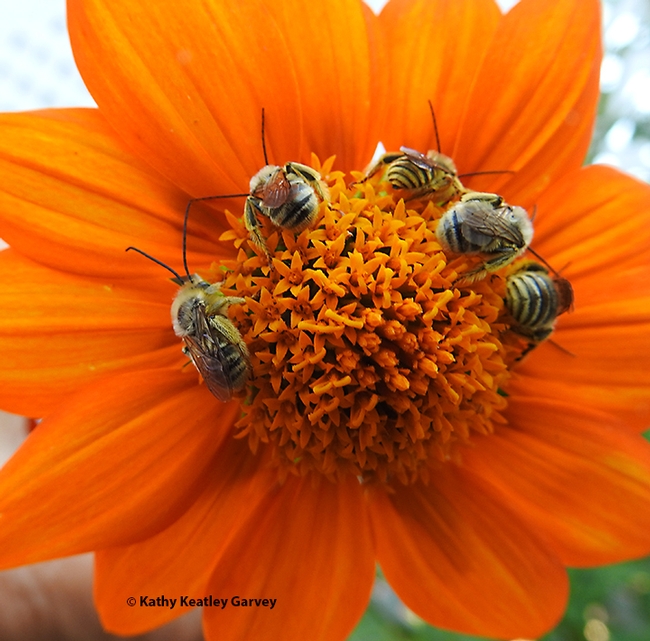
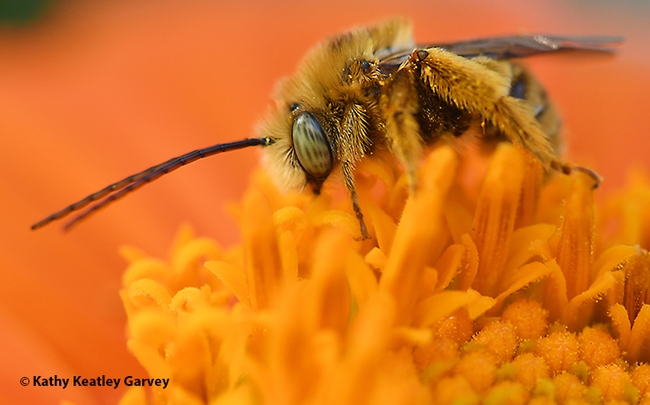
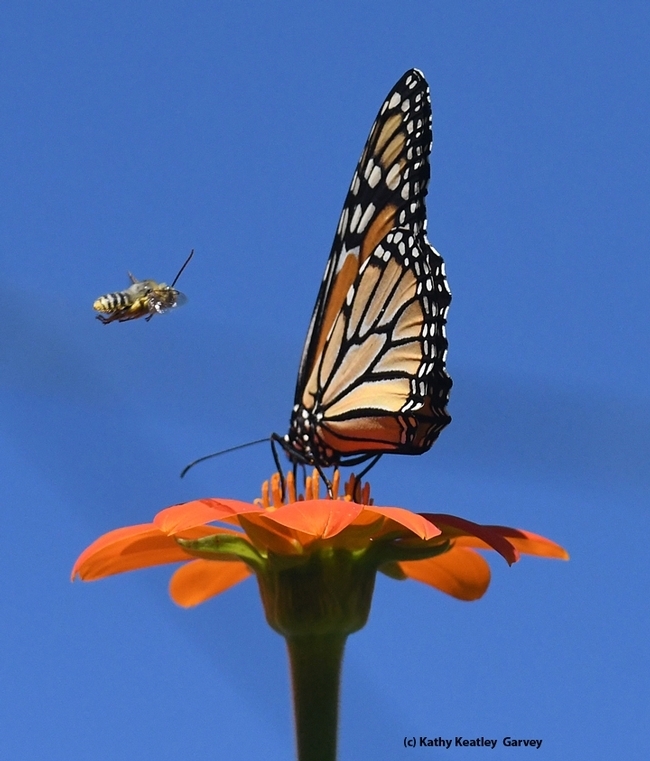
- Author: Kathy Keatley Garvey
It's Day 3 of National Pollinator Week.
Fortunately, a tiger came to visit us--no, not the predatory jungle animal, Panthera tigris, but a newly emerged Western tiger swallowtail, Papilio rutulus.
This native butterfly is quite colorful, with black stripes accenting its brilliant yellow wings, and blue and orange spots gracing its tail. When it flutters into your garden, you stop everything you're doing and become a professional butterfly watcher until it leaves. It's the law, I think. Anyway, Western tiger swallowtails are almost hypnotic.
This fluttering tiger took a liking to our Mexican sunflower, Tithonia rotundifola, and was totally unaware of a tiny longhorned bee, a male Melissodes agilis, heading straight for it.
Pretend you're the butterfly. Here you are, newly emerged and you've discovered a patch of Tithonia offering delicious nectar! Heaven scent! Then you see a speedy little critter targeting you. He's not about to make a lane change. There's no garden patrol to monitor his speed or aggressive behavior. He's coming for you. He aims to hit you and dislodge you from your perch.
This little bee, in fact, targets all critters occupying "his" flowers. He isn't out to sting the floral occupants, as one reader surmised. It's a male bee, and boy bees can't sting. Nor is he fighting over pollen. Males do not collect pollen or nectar for their colony--the females do.
So what is he doing? He's trying to protect or save the floral resources for the females of the species so he can mate with them. The late Robbin Thorp, noted bee expert and distinguished emeritus professor of entomology at UC Davis, used to talk about these little guys bullying all the floral tenants--from Valley carpenter bees to majestic monarchs to praying mantids. Sometimes an unfortunate Melissodes winds up in the spiked forelegs of a mantis. Or in the clutches of a spider. Or in the beak of a bird.
It's a jungle out there. Sometimes it's the survival of the fittest. Or the flittest.
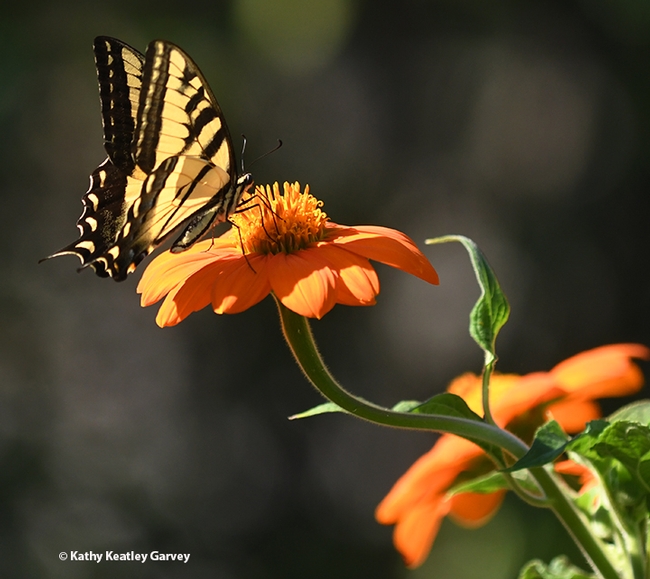
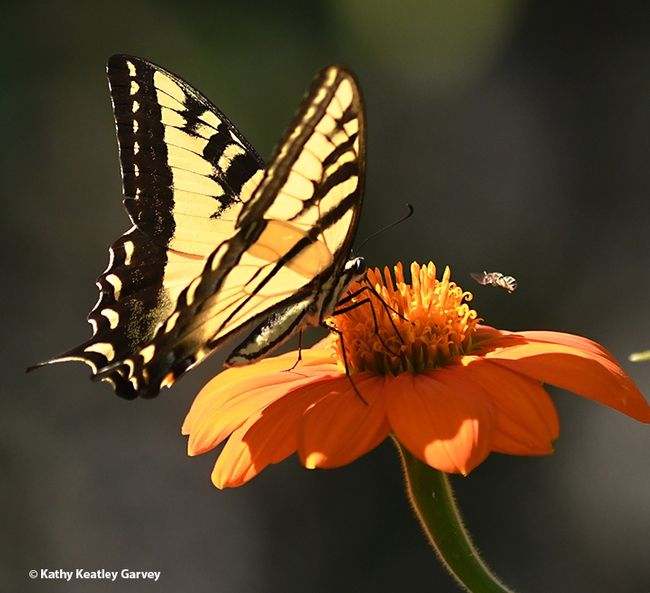
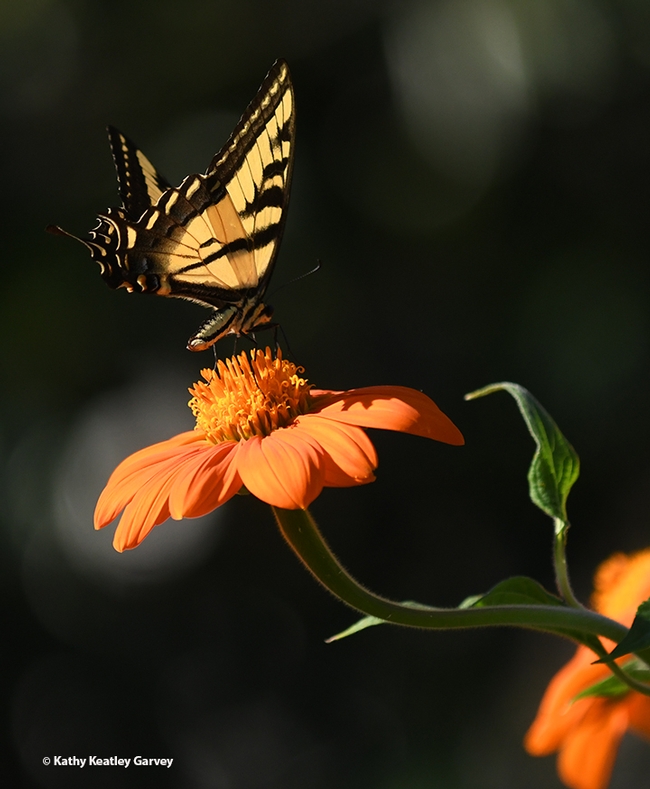
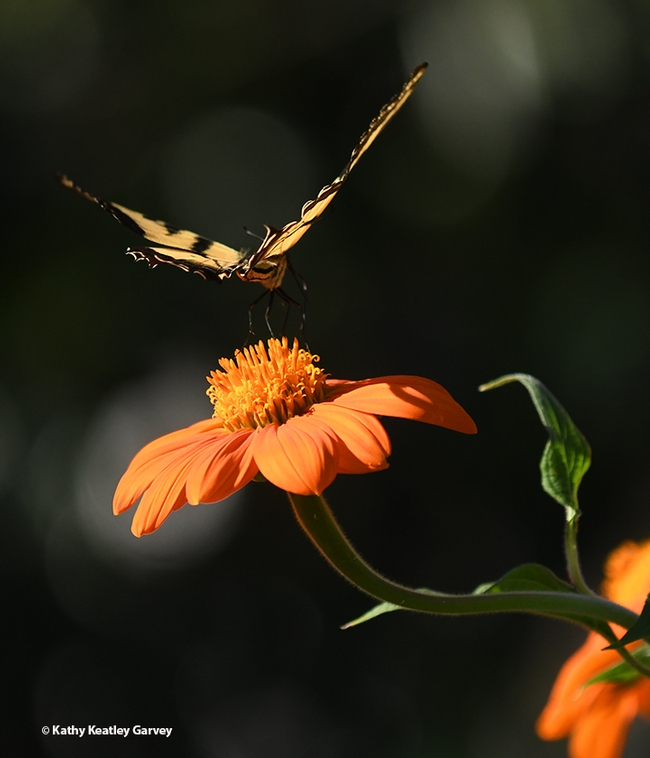
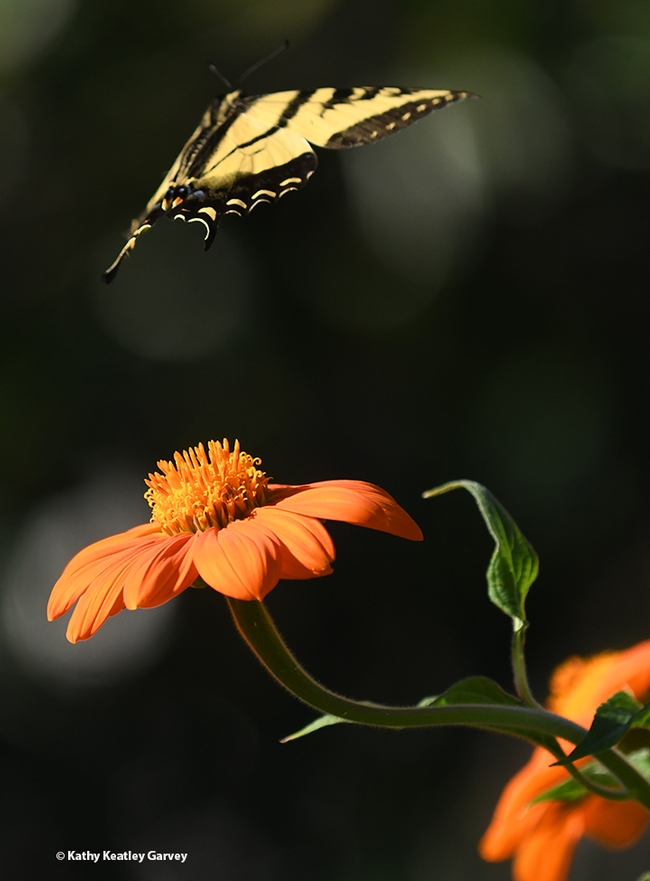
- Author: Kathy Keatley Garvey
It was July 3, 2020.
The male bees, Melissodes agilis, were getting quite territorial.
Every time a butterfly, a honey bee or another insect in our family's pollinator garden expressed an interest in foraging on the Mexican sunflowers, Tithonia rotundifola, a male Melissodes buzzed them.
"Get out of here!" he threatened. "I own these flowers. These are mine!"
What to do? I grabbed my Nikon D500 and 200 mm macro lens, adjusted the settings to 1/5000 of a second, f-stop 5.6, ISO of 800, and managed to get a shot of the menacing bee confronting a bewildered monarch.
Eye-to-eye. Antenna-to-antenna. Wing-to-wing.
What happened? The monarch quickly escaped the wrath.
And the bee? It buzzed off, only to return to target another insect.
"Get out of here! I own these flowers. These are mine!"
Another tiff on the Tithonia. Another round on the rotundifola.
Just another day in the pollinator garden.

- Author: Kathy Keatley Garvey
What was that!
If you grow Mexican sunflowers (Tithonia) in your pollinator garden, you've probably noticed the fast-flying longhorned male bees being totally territorial.
Their job is to target whatever's on the Tithonia. It doesn't matter if it's a bumble bee, a honey bee, or a butterfly--it's fair game.
As the late Robbin Thorp (1933-2019), a global expert on bees and a distinguished emeritus professor of entomology at the University of California, Davis, used to say about the male longhorned bees, Melissodes agilis: "They're trying to save the flowers for their own species, per chance to mate with them."
Watching the territorial behavior is jaw-dropping, but imagine if you're a butterfly trying to sip a little nectar.
"Oh no! What was that heading straight at me?"
"Horrors! Here he comes again! Can't a pollinator get a little peace around here?"
The longhorned bee, Melissodes agilis, is just one of the more than 1600 species of bees found in California. If you want to learn more about them, be sure to read California Bees and Blooms: A Guide for Gardeners and Naturalists (Heyday, 2014), co-authored by scientists from UC Berkeley and UC Davis.
"California Bees and Blooms (co-authored by Gordon Frankie, Robbin Thorp, Barbara Ertter and Rollin Coville) holds a magnifying glass up to the twenty-two most common genera (and six species of cuckoo bees), describing each one's distinctive behaviors, social structures, flight season, preferred flowers, and enemies," according to Heyday.
That it does. And if you try to stop the action with your camera, it helps to set the shutter speed at 1/3000 to 1/4000 of a second. (The two images of the bee and painted lady butterfly captured with a Nikon D500 camera, mounted with a 70-180 mm macro zoom lens, with the aperture set at 5.6 and ISO at 800. Image of the bee and monarch taken with a Nikon D800 mounted with a 105mm lens, and with similar settings.)
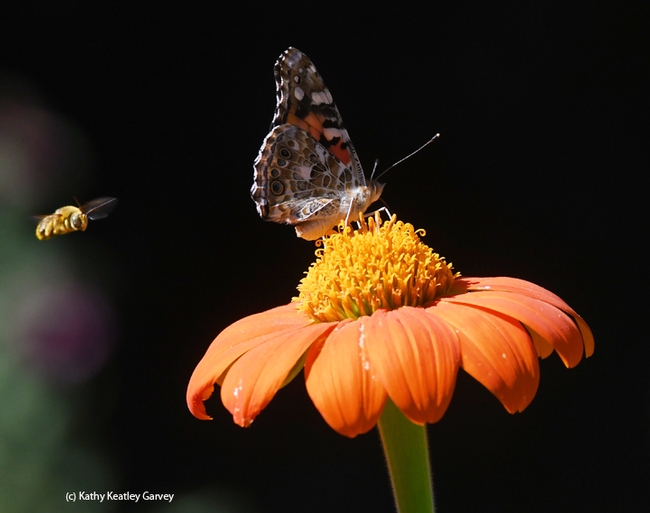
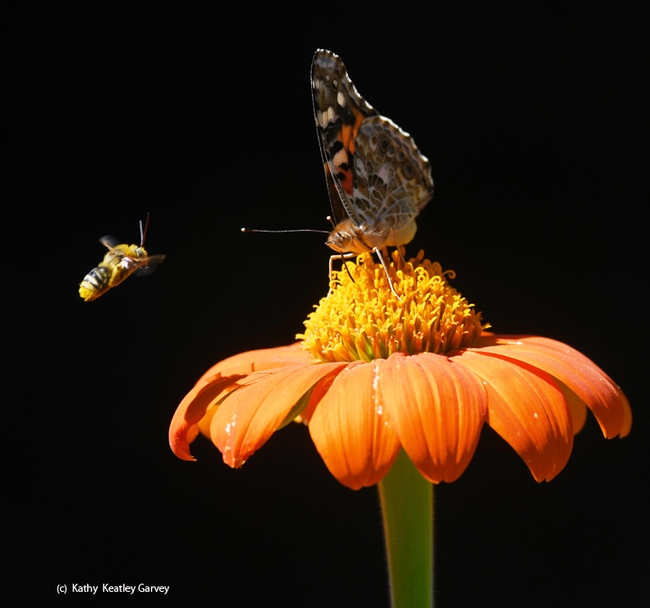

- Author: Kathy Keatley Garvey
Boys' Night Out!
Have you ever seen a cluster of longhorned male bees sleeping overnight on a Mexican sunflower (Tithonia)?
Every day around sunset, the longhorned bees, probably Melissodes agilis (tribe Eucerini), call it a day and head for their favorite flower (bedroom), which happens to be Tithonia in our pollinator garden in Vacaville. If you grow flowers for the native bees, and you wake up early in the morning before they do, you may see them, too.
The late native pollinator specialist Robbin Thorp (1933-2019), distinguished emeritus professor at the University of California, Davis, used to call this behavior "Boys' Night Out."
"Most frequently, the boy bee overnight clusters are single-species clusters," said Thorp, co-author of California Bees and Blooms, a Guide for Gardeners and Naturalists, with UC-affiliated authors Gordon Frankie, Rollin E. Coville, and Barbara Ertter. He previously identified some of ours as Melissodes agilis.
In a previous Bug Squad blog, Thorp responded to a reader's inquiry about "stings" from the clustering bees. "Boy bees cannot sting," he pointed out. "They lack a stinger which is a modified ovipositor in their wasp ancestors. Occasionally a girl bee may spend the night out if she is caught by sudden drop in temperature. Usually she will not be part of a group sleep over. So don't attempt to handle unless you are confident you can tell boy bees from girl bees or they are too sleepy to defend themselves."
The reader also asked: "Typically how close to the girls' nest(s) do the boys' slumber? I want to try and make sure I don't touch it when planting at end of summer."
"Boy sleeping aggregations are based on a suitable perch and not related to where females are nesting, but probably no more than 100 yards from the nearest female nest," Thorp answered. "Females nest in the ground and have rather distinctive round holes about the diameter of a pencil or slightly smaller, sometimes with small piles of dirt around them looking like mini-volcanos. The holes may be widely separated or clustered together depending on the species, but each female digs her own burrow."
The reader also wondered: "When watching the boys tonight, about ten of them started waking up and kicking each other. They finally settled down and started to nestle back in for the 'night'--it was only 6 p.m.--but I wasn't sure if my presence was getting them riled or they tend to act like kids sharing a bed?"
Said Thorp: "The boys usually settle in as the light dims in the evening. Cool, and drizzly conditions may modify bed time. Each establishes his own spot, so there may be some jostling for position initially."
Longhorned bees are among the more than 1600 species of undomesticated bees that reside in California. The co-authors of California Bees and Blooms focus on 22 of the most common genera and the flowers they frequent.
